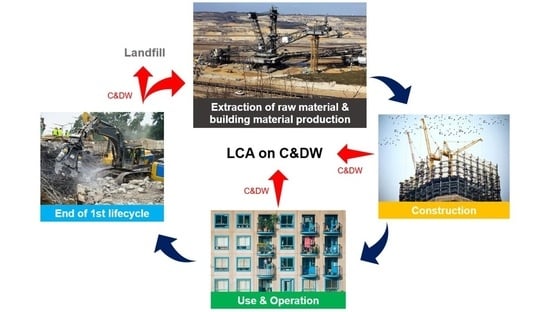Life Cycle Assessment on Construction and Demolition Waste: A Systematic Literature Review
Abstract
:1. Introduction
2. Methods
2.1. Literature Review
2.2. Bibliometric and Based-Content Analysis
3. Results
3.1. Bibliometric Analysis
3.2. Content-Based Analysis
3.2.1. Research Topics
- Material Selection/Definition of C&DW Fraction for Construction Applications
- EOL Decision-Making
- Waste Management Systems
- Other Trends
3.2.2. Common Findings
- LCA demonstrates the reduction of this new material on the global warming potential of concrete. Reductions from 66 to 70% are possible for high strength concrete with low clinker content and 7–35% with a higher clinker content [135]. Similarly, [132] developed a comparative analysis of recycled and conventional concrete. Results demonstrated a reduction of (−30%) environmental impacts for Eco-Indicator 99 and ecological scarcity.
- It is necessary to analyze the environmental performance of a system from different perspectives before decision-making. Recycling waste is not always the best alternative for C&DW; it depends on regional differences in operations and waste composition [43].
- Benefits from substituting primary raw materials can be overset by the increased impacts due to additional energy requirements of the selective demolition compared to the traditional one. Consequently, the environmental sustainability of selective demolition should be addressed on a case-by-case basis [124].
- Preventative models can support the preparation of national waste programs and could serve as an instrumental tool to simulate the environmental impacts of construction waste management scenarios that include waste prevention [34].
- LCA and GIS (geographical information systems) provide beneficial results to analyze EOL scenarios by considering the number, size, type, and location of recycling plants [141].
4. Discussion
5. Barriers and Future Challenges
- LCA is a method based on data inventory; therefore, the robustness of each analysis depends on the availability of data to measure and compare environmental indicators. A significant proportion of selected works (30% approximately) employed a complete set of environmental indicators. Meanwhile, most of the works (50% approximately) employ one to four indicators. This demonstrates a bias in the implementation of the method in the group of selected works. This situation makes it difficult to make a detailed comparison among the research works with traceability and reliability.
- There are no widely extended policies related to the disposal of debris in construction sites and the threshold of recycled-content building materials [17,144]. This is evidenced in the type of approach proposed by most research works based on local analysis (municipalities, cities, or regions). Therefore, there is no formal approach to evaluate C&DW through LCA in a world unified methodology. The consequences of this situation can be seen on a larger scale in the European Union (Figure 9), where although the recovery average of C&DW is around 30%, the situation varies from country to country. For example, southern countries such as Spain, Portugal, and Greece only recover approximately 5% of the generated C&DW, while northern countries such as Holland, Belgium, and Denmark recover more than 80% of the CD&DW.
- The economic viability of C&DW management is insufficient to guarantee its implementation. Other factors must be included in the analysis, such as logistic deadlines, availability of resources, transportation issues, derived environmental impacts, among others [150]. It is necessary to have an entire database of environmental and technical data from all raw materials (including geographical origin) to develop robust analysis based on a sustainability perspective that includes environmental and social aspects.
- Commonly, it is concluded that recycling is more sustainable, but from an absolute perspective, it can cause an unacceptable impact on the environment [150]. The impact of recycling must be considered in any LCA analysis using a case-by-case basis.
- According to the results previously explained and discussed, five main research challenges need to be addressed to improve the applicability and effectiveness of LCA approaches to study C&DW.
- LCA implementations found in the existing literature focus on specific locations or cities; there is no traceability of the primary source of materials that can even be imported from distant regions. A robust LCA approach should consider the entire life cycle, considering socioeconomic conditions of locations or countries where raw material is obtained and processed until it is delivered as a construction material or product. The same consideration should be included to select the most suitable EOL alternative of C&DW, involving long travel distances.
- Most research works are focused on recycling concrete or aggregates of different nature. However, it is necessary to propose new approaches that provide different circular economy strategies such as repair or repurpose to avoid reprocessing of C&DW material that can be more expensive in terms of cost and environment. Recycling is considered one of the less desirable among the circular economy strategies [154,155], since it involves using resources (energy, water, additional supplies) that can be significant compared to the extraction of virgin material. Nevertheless, due to the nature of construction materials, it is difficult to apply many strategies compared to electronics, industrial machines, and domestic appliances.
- Dedicated design methodologies that include prediction of environmental impact, maintenance tasks, and demolition processes must integrate LCA data from early design phases. Building information modeling presents vast potential as a tool for including LCA aspects and facilitating the waste management of buildings during their EOL stage.
- Industry 4.0 technology and advanced techniques such as artificial intelligence, machine learning, and digital twin are required to boost new research efforts for building project design and waste management. In addition, simulation tools and modeling software need to include material property databases to assess and select materials from early design phases. Thus, it facilitates calculations and the decision-making of construction materials and their fractions when C&DW sources are considered for replacing virgin material.
- More research is required to evaluate the role of legislation and policies in different countries related to the waste management of C&DW and their evolution during the last decade. For example, stimulating and controlling approaches should be considered to move construction to a circular economy model. In addition, some new business models associated with the servitization of buildings (co-living, working spaces, rent-based offices) must be assessed in the use stage to compensate for possible costs during the EOL phase.
6. Conclusions
Author Contributions
Funding
Institutional Review Board Statement
Informed Consent Statement
Data Availability Statement
Acknowledgments
Conflicts of Interest
Appendix A. Full Search Query Employed in SCOPUS Database
References
- Nasab, T.J.; Monavari, S.M.; Jozi, S.A.; Majedi, H. Assessment of carbon footprint in the construction phase of high-rise constructions in Tehran. Int. J. Environ. Sci. Technol. 2020, 17, 3153–3164. [Google Scholar] [CrossRef]
- Ruuska, A.; Häkkinen, T. Material efficiency of building construction. Buildings 2014, 4, 266–294. [Google Scholar] [CrossRef] [Green Version]
- Ortiz, O.; Pasqualino, J.C.; Castells, F. Environmental performance of construction waste: Comparing three scenarios from a case study in Catalonia, Spain. Waste Manag. 2010, 30, 646–654. [Google Scholar] [CrossRef]
- Hu, M.; Kleijn, R.; Bozhilova-Kisheva, K.P.; di Maio, F. An approach to LCSA: The case of concrete recycling. Int. J. Life Cycle Assess. 2013, 18, 1793–1803. [Google Scholar] [CrossRef]
- Guignot, S.; Touzé, S.; von der Weid, F.; Ménard, Y.; Villeneuve, J. Recycling Construction and Demolition Wastes as Building Materials: A Life Cycle Assessment. J. Ind. Ecol. 2015, 19, 1030–1043. [Google Scholar] [CrossRef]
- Junior, A.C.P.; Jacinto, C.; Oliveira, T.M.; Polisseni, A.E.; Brum, F.M.; Teixeira, E.R.; Mateus, R. Characterisation and life cycle assessment of pervious concrete with recycled concrete aggregates. Crystals 2021, 11, 209. [Google Scholar] [CrossRef]
- Zhang, C.; Hu, M.; Dong, L.; Xiang, P.; Zhang, Q.; Wu, J.; Li, B.; Shi, S. Co-benefits of urban concrete recycling on the mitigation of greenhouse gas emissions and land use change: A case in Chongqing metropolis, China. J. Clean. Prod. 2018, 201, 481–498. [Google Scholar] [CrossRef]
- Zhang, C.; Hu, M.; Dong, L.; Gebremariam, A.; Miranda-Xicotencatl, B.; Di Maio, F.; Tukker, A. Eco-efficiency assessment of technological innovations in high-grade concrete recycling. Resour. Conserv. Recycl. 2019, 149, 649–663. [Google Scholar] [CrossRef]
- Jalaei, F.; Zoghi, M.; Khoshand, A. Life cycle environmental impact assessment to manage and optimize construction waste using Building Information Modeling (BIM). Int. J. Constr. Manag. 2019, 1–18. [Google Scholar] [CrossRef]
- Zoghi, M.; Kim, S. Dynamic modeling for life cycle cost analysis of BIM-based construction waste management. Sustainability 2020, 12, 2483. [Google Scholar] [CrossRef] [Green Version]
- Ram, V.G.; Kishore, K.C.; Kalidindi, S.N. Environmental benefits of construction and demolition debris recycling: Evidence from an Indian case study using life cycle assessment. J. Clean. Prod. 2020, 255, 120258. [Google Scholar] [CrossRef]
- Narayanaswamy, A.H.; Walker, P.; Reddy, B.V.V.; Heath, A.; Maskell, D. Mechanical and thermal properties, and comparative life-cycle impacts, of stabilised earth building products. Constr. Build. Mater. 2020, 243, 118096. [Google Scholar] [CrossRef]
- Kvočka, D.; Lešek, A.; Knez, F.; Ducman, V.; Panizza, M.; Tsoutis, C.; Bernardi, A. Life cycle assessment of prefabricated geopolymeric façade cladding panels made from large fractions of recycled construction and demolition waste. Materials 2020, 13, 3931. [Google Scholar] [CrossRef] [PubMed]
- Di Maria, A.; Eyckmans, J.; van Acker, K. Downcycling versus recycling of construction and demolition waste: Combining LCA and LCC to support sustainable policy making. Waste Manag. 2018, 75, 3–21. [Google Scholar] [CrossRef]
- Yeheyis, M.; Hewage, K.; Alam, M.S.; Eskicioglu, C.; Sadiq, R. An overview of construction and demolition waste management in Canada: A life-cycle analysis approach to sustainability. Clean Technol. Environ. Policy 2013, 15, 81–91. [Google Scholar] [CrossRef]
- Di Maria, A.; Eyckmans, J.; van Acker, K. Use of LCA and LCC to help decision-making between downcycling versus recycling of construction and demolition waste. In Advances in Construction and Demolition Waste Recycling; Woodhead Publishing: Sawston, UK, 2020; pp. 537–558. [Google Scholar]
- Blengini, G.A. Life cycle of buildings, demolition and recycling potential: A case study in Turin, Italy. Build. Environ. 2009, 44, 319–330. [Google Scholar] [CrossRef]
- Laurent, A.; Bakas, I.; Clavreul, J.; Bernstad, A.; Niero, M.; Gentil, E.; Hauschild, M.Z.; Christensen, T.H. Review of LCA studies of solid waste management systems-Part I: Lessons learned and perspectives. Waste Manag. 2014, 34, 573–588. [Google Scholar] [CrossRef]
- Bovea, M.D.; Powell, J.C. Developments in life cycle assessment applied to evaluate the environmental performance of construction and demolition wastes. Waste Manag. 2016, 50, 151–172. [Google Scholar] [CrossRef]
- Vieira, D.R.; Calmon, J.L.; Coelho, F.Z. Life cycle assessment (LCA) applied to the manufacturing of common and ecological concrete: A review. Constr. Build. Mater. 2016, 124, 656–666. [Google Scholar] [CrossRef]
- Wu, H.; Zuo, J.; Yuan, H.; Zillante, G.; Wang, J. A review of performance assessment methods for construction and demolition waste management. Resour. Conserv. Recycl. 2019, 150, 104407. [Google Scholar] [CrossRef]
- Rosado, L.P.; Penteado, C.S.G. Municipal management of construction and demolition waste: Influence of disposal fees. Ambient. Soc. 2020, 23, 1–21. [Google Scholar] [CrossRef]
- Salgado, R.A.; Apul, D.; Guner, S. Life cycle assessment of seismic retrofit alternatives for reinforced concrete frame buildings. J. Build. Eng. 2020, 28, 101064. [Google Scholar] [CrossRef]
- Sözer, H.; Sözen, H. Waste capacity and its environmental impact of a residential district during its life cycle. Energy Rep. 2020, 6, 286–296. [Google Scholar] [CrossRef]
- Sözer, H.; Sözen, H.; Utkucu, D. Waste potential of a building through gate-to-grave approach based on Life Cycle Assessment (LCA). Int. J. Sustain. Dev. Plan. 2020, 15, 165–171. [Google Scholar] [CrossRef]
- Umadevi, P.; Pradeep, T. A review on environmental, economic and social facets of construction & demolition waste management. Int. J. Adv. Sci. Technol. 2020, 29, 4692–4697. [Google Scholar]
- Zhang, J.; Ding, L.; Li, F.; Peng, J. Recycled aggregates from construction and demolition wastes as alternative filling materials for highway subgrades in China. J. Clean. Prod. 2020, 255, 120223. [Google Scholar] [CrossRef]
- Zhao, Z.; Courard, L.; Groslambert, S.; Jehin, T.; Léonard, A.; Xiao, J. Use of recycled concrete aggregates from precast block for the production of new building blocks: An industrial scale study. Resour. Conserv. Recycl. 2020, 157, 104786. [Google Scholar] [CrossRef]
- Agrela, F.; Díaz-López, J.L.; Rosales, J.; Cuenca-Moyano, G.M.; Cano, H.; Cabrera, M. Environmental assessment, mechanical behavior and new leaching impact proposal of mixed recycled aggregates to be used in road construction. J. Clean. Prod. 2021, 280. [Google Scholar] [CrossRef]
- Bogoviku, L.; Waldmann, D. Modelling of mineral construction and demolition waste dynamics through a combination of geospatial and image analysis. J. Environ. Manag. 2021, 282. [Google Scholar] [CrossRef]
- Bonoli, A.; Zanni, S.; Serrano-Bernardo, F. Sustainability in building and construction within the framework of circular cities and european new green deal. The contribution of concrete recycling. Sustainability 2021, 13, 2139. [Google Scholar] [CrossRef]
- Caneda-martínez, L.; Monasterio, M.; Moreno-juez, J.; Martínez-ramírez, S.; García, R.; Frías, M. Behaviour and properties of eco-cement pastes elaborated with recycled concrete powder from construction and demolition wastes. Materials 2021, 14, 1299. [Google Scholar] [CrossRef] [PubMed]
- Li, J.; Zhang, J.; Ni, S.; Liu, L.; Walubita, L.F. Mechanical performance and environmental impacts of self-compacting concrete with recycled demolished concrete blocks. J. Clean. Prod. 2021, 293, 126129. [Google Scholar] [CrossRef]
- Llatas, C.; Bizcocho, N.; Soust-Verdaguer, B.; Montes, M.V.; Quiñones, R. An LCA-based model for assessing prevention versus non-prevention of construction waste in buildings. Waste Manag. 2021, 126, 608–622. [Google Scholar] [CrossRef] [PubMed]
- Nguyen, W.; Martinez, D.M.; Jen, G.; Duncan, J.F.; Ostertag, C.P. Interaction between global warming potential, durability, and structural properties of fiber-reinforced concrete with high waste materials inclusion. Resour. Conserv. Recycl. 2021, 169, 105453. [Google Scholar] [CrossRef]
- Resch, E.; Andresen, I.; Cherubini, F.; Brattebø, H. Estimating dynamic climate change effects of material use in buildings—Timing, uncertainty, and emission sources. Build. Environ. 2021, 187, 107399. [Google Scholar] [CrossRef]
- Sormunen, P.; Deviatkin, I.; Horttanainen, M.; Kärki, T. An evaluation of thermoplastic composite fillers derived from construction and demolition waste based on their economic and environmental characteristics. J. Clean. Prod. 2021, 280. [Google Scholar] [CrossRef]
- Zhou, A.; Zhang, W.; Wei, H.; Liu, T.; Zou, D.; Guo, H. A novel approach for recycling engineering sediment waste as sustainable supplementary cementitious materials. Resour. Conserv. Recycl. 2021, 167, 105435. [Google Scholar] [CrossRef]
- Wang, J.; Wu, H.; Duan, H.; Zillante, G.; Zuo, J.; Yuan, H. Combining life cycle assessment and Building Information Modelling to account for carbon emission of building demolition waste: A case study. J. Clean. Prod. 2016, 172, 3154–3166. [Google Scholar] [CrossRef]
- Wu, Z.; Yu, A.T.W.; Poon, C.S. An off-site snapshot methodology for estimating building construction waste composition—A case study of Hong Kong. Environ. Impact Assess. Rev. 2019, 77, 128–135. [Google Scholar] [CrossRef]
- Butera, S.; Christensen, T.H.; Astrup, T.F. Life cycle assessment of construction and demolition waste management. Waste Manag. 2015, 44, 196–205. [Google Scholar] [CrossRef] [Green Version]
- Cao, X.; Li, X.; Zhu, Y.; Zhang, Z. A comparative study of environmental performance between prefabricated and traditional residential buildings in China. J. Clean. Prod. 2015, 109, 131–143. [Google Scholar] [CrossRef]
- Dahlbo, H.; Bachér, J.; Lähtinen, K.; Jouttijärvi, T.; Suoheimo, P.; Mattila, T.; Sironen, S.; Myllymaa, T.; Saramäki, K. Construction and demolition waste management—A holistic evaluation of environmental performance. J. Clean. Prod. 2015, 107, 333–341. [Google Scholar] [CrossRef]
- Fu, F.; Sun, J.; Pasquire, C. Carbon Emission Assessment for Steel Structure Based on Lean Construction Process. J. Intell. Robot. Syst. Theory Appl. 2015, 79, 401–416. [Google Scholar] [CrossRef]
- Hol, G.H.P. Building a green swimming pool by using concrete with aggregates from demolition waste. Procedia Eng. 2015, 125, 613–616. [Google Scholar] [CrossRef] [Green Version]
- Ng, W.Y.; Chau, C.K. New Life of the Building Materials-Recycle, Reuse and Recovery. Energy Procedia 2015, 75, 2884–2891. [Google Scholar] [CrossRef] [Green Version]
- Tošić, N.; Marinković, S.; Dašić, T.; Stanić, M. Multicriteria optimization of natural and recycled aggregate concrete for structural use. J. Clean. Prod. 2015, 87, 766–776. [Google Scholar] [CrossRef]
- Udawatta, N.; Zuo, J.; Chiveralls, K.; Zillante, G. Improving waste management in construction projects: An Australian study. Resour. Conserv. Recycl. 2015, 101, 73–83. [Google Scholar] [CrossRef]
- Estanqueiro, B.; Silvestre, J.D.; de Brito, J.; Pinheiro, M.D. Environmental life cycle assessment of coarse natural and recycled aggregates for concrete. Eur. J. Environ. Civ. Eng. 2018, 22, 429–449. [Google Scholar] [CrossRef]
- Faleschini, F.; Zanini, M.A.; Pellegrino, C.; Pasinato, S. Sustainable management and supply of natural and recycled aggregates in a medium-size integrated plant. Waste Manag. 2016, 49, 146–155. [Google Scholar] [CrossRef]
- Kucukvar, M.; Egilmez, G.; Tatari, O. Life cycle assessment and optimization-based decision analysis of construction waste recycling for a LEED-certified university building. Sustainability 2016, 8, 89. [Google Scholar] [CrossRef] [Green Version]
- Gayarre, F.L.; Pérez, J.G.; Pérez, C.L.; López, M.S.; Martínez, A.L. Life cycle assessment for concrete kerbs manufactured with recycled aggregates. J. Clean. Prod. 2016, 113, 41–53. [Google Scholar] [CrossRef]
- Mortaheb, M.M.; Mahpour, A. Integrated construction waste management, a holistic approach. Sci. Iran. 2016, 23, 2044–2056. [Google Scholar] [CrossRef] [Green Version]
- Sou, W.I.; Chu, A.; Chiueh, P.T. Sustainability assessment and prioritisation of bottom ash management in Macao. Waste Manag. Res. 2016, 34, 1275–1282. [Google Scholar] [CrossRef] [PubMed]
- Suárez, S.; Roca, X.; Gasso, S. Product-specific life cycle assessment of recycled gypsum as a replacement for natural gypsum in ordinary Portland cement: Application to the Spanish context. J. Clean. Prod. 2016, 117, 150–159. [Google Scholar] [CrossRef]
- Hossain, M.U.; Poon, C.S.; Lo, I.M.C.; Cheng, J.C.P. Comparative environmental evaluation of aggregate production from recycled waste materials and virgin sources by LCA. Resour. Conserv. Recycl. 2016, 109, 67–77. [Google Scholar] [CrossRef]
- Hossain, M.U.; Poon, C.S.; Lo, I.M.C.; Cheng, J.C.P. Evaluation of environmental friendliness of concrete paving eco-blocks using LCA approach. Int. J. Life Cycle Assess. 2016, 21, 70–84. [Google Scholar] [CrossRef]
- Tang, X.; Li, C.; Hu, S.; Liu, Y.; Geng, H. Evaluating extended land consumption in building life cycle to improve land conservation: A case study in Shenyang, China. Resour. Conserv. Recycl. 2016, 109, 78–89. [Google Scholar] [CrossRef]
- Zambrana-Vasquez, D.; Zabalza-Bribián, I.; Jáñez, A.; Aranda-Usón, A. Analysis of the environmental performance of life-cycle building waste management strategies in tertiary buildings. J. Clean. Prod. 2016, 130, 143–154. [Google Scholar] [CrossRef] [Green Version]
- Penteado, C.S.G.; Rosado, L.P. Comparison of scenarios for the integrated management of construction and demolition waste by life cycle assessment: A case study in Brazil. Waste Manag. Res. 2016, 34, 1026–1035. [Google Scholar] [CrossRef] [PubMed]
- Arm, M.; Wik, O.; Engelsen, C.J.; Erlandsson, M.; Hjelmar, O.; Wahlström, M. How Does the European Recovery Target for Construction & Demolition Waste Affect Resource Management? Waste Biomass Valoriz. 2017, 8, 1491–1504. [Google Scholar] [CrossRef] [Green Version]
- Cuenca-Moyano, G.M.; Zanni, S.; Bonoli, A.; Valverde-Palacios, I. Development of the life cycle inventory of masonry mortar made of natural and recycled aggregates. J. Clean. Prod. 2017, 140, 1272–1286. [Google Scholar] [CrossRef]
- Ghanbari, M.; Abbasi, A.M.; Ravanshadnia, M. Economic and Environmental Evaluation and Optimal Ratio of Natural and Recycled Aggregate Production. Adv. Mater. Sci. Eng. 2017, 2017. [Google Scholar] [CrossRef] [Green Version]
- Ghanbari, M.; Abbasi, A.M.; Ravanshadnia, M. Environmental Life Cycle Assessment and Cost Analysis of Aggregate Production Industries. Appl. Ecol. Environ. Res. 2017, 15, 1577–1593. [Google Scholar] [CrossRef]
- Ghose, A.; Pizzol, M.; McLaren, S.J. Consequential LCA modelling of building refurbishment in New Zealand- an evaluation of resource and waste management scenarios. J. Clean. Prod. 2017, 165, 119–133. [Google Scholar] [CrossRef]
- Mah, C.M.; Fujiwara, T.; Ho, C.S. Concrete waste management decision analysis based on life cycle assessment. Chem. Eng. Trans. 2017, 56, 25–30. [Google Scholar] [CrossRef]
- Mastrucci, A.; Marvuglia, A.; Popovici, E.; Leopold, U.; Benetto, E. Geospatial characterization of building material stocks for the life cycle assessment of end-of-life scenarios at the urban scale. Resour. Conserv. Recycl. 2017, 123, 54–66. [Google Scholar] [CrossRef]
- Rosado, L.P.; Vitale, P.; Penteado, C.S.G.; Arena, U. Life cycle assessment of natural and mixed recycled aggregate production in Brazil. J. Clean. Prod. 2017, 151, 634–642. [Google Scholar] [CrossRef]
- Shan, X.; Zhou, J.; Chang, V.W.C.; Yang, E.H. Life cycle assessment of adoption of local recycled aggregates and green concrete in Singapore perspective. J. Clean. Prod. 2017, 164, 918–926. [Google Scholar] [CrossRef]
- Hossain, M.U.; Wu, Z.; Poon, C.S. Comparative environmental evaluation of construction waste management through different waste sorting systems in Hong Kong. Waste Manag. 2017, 69, 325–335. [Google Scholar] [CrossRef]
- Vitale, P.; Arena, U. An attributional life cycle assessment for an Italian residential multifamily building. Environ. Technol. 2017, 39, 3033–3045. [Google Scholar] [CrossRef]
- Vitale, P.; Arena, N.; di Gregorio, F.; Arena, U. Life cycle assessment of the end-of-life phase of a residential building. Waste Manag. 2017, 60, 311–321. [Google Scholar] [CrossRef] [PubMed]
- Bizcocho, N.; Llatas, C. Inclusion of prevention scenarios in LCA of construction waste management. Int. J. Life Cycle Assess. 2019, 24, 468–484. [Google Scholar] [CrossRef]
- Borghi, G.; Pantini, S.; Rigamonti, L. Life cycle assessment of non-hazardous Construction and Demolition Waste (CDW) management in Lombardy Region (Italy). J. Clean. Prod. 2018, 184, 815–825. [Google Scholar] [CrossRef]
- Mah, C.M.; Fujiwara, T.; Ho, C.S. Environmental impacts of construction and demolition waste management alternatives. Chem. Eng. Trans. 2018, 63, 343–348. [Google Scholar] [CrossRef]
- Cuenca-Moyano, G.M.; Martín-Morales, M.; Bonoli, A.; Valverde-Palacios, I. Environmental assessment of masonry mortars made with natural and recycled aggregates. Int. J. Life Cycle Assess. 2019, 24, 191–210. [Google Scholar] [CrossRef]
- Ghanbari, M.; Abbasi, A.M.; Ravanshadnia, M. Production of natural and recycled aggregates: The environmental impacts of energy consumption and CO2 emissions. J. Mater. Cycles Waste Manag. 2018, 20, 810–822. [Google Scholar] [CrossRef]
- Göswein, V.; Gonçalves, A.B.; Silvestre, J.D.; Freire, F.; Habert, G.; Kurda, R. Transportation matters—Does it? GIS-based comparative environmental assessment of concrete mixes with cement, fly ash, natural and recycled aggregates. Resour. Conserv. Recycl. 2018, 137, 1–10. [Google Scholar] [CrossRef]
- Heeren, N.; Hellweg, S. Tracking Construction Material over Space and Time: Prospective and Geo-referenced Modeling of Building Stocks and Construction Material Flows. J. Ind. Ecol. 2019, 23, 253–267. [Google Scholar] [CrossRef] [Green Version]
- Lockrey, S.; Verghese, K.; Crossin, E.; Nguyen, H. Concrete recycling life cycle flows and performance from construction and demolition waste in Hanoi. J. Clean. Prod. 2018, 179, 593–604. [Google Scholar] [CrossRef]
- Palacios-Munoz, B.; Gracia-Villa, L.; Zabalza-Bribián, I.; López-Mesa, B. Simplified structural design and LCA of reinforced concrete beams strengthening techniques. Eng. Struct. 2018, 174, 418–432. [Google Scholar] [CrossRef] [Green Version]
- Pantini, S.; Borghi, G.; Rigamonti, L. Towards resource-efficient management of asphalt waste in Lombardy region (Italy): Identification of effective strategies based on the LCA methodology. Waste Manag. 2018, 80, 423–434. [Google Scholar] [CrossRef] [PubMed]
- Seco, A.; Omer, J.; Marcelino, S.; Espuelas, S.; Prieto, E. Sustainable unfired bricks manufacturing from construction and demolition wastes. Constr. Build. Mater. 2018, 167, 154–165. [Google Scholar] [CrossRef]
- Silgado, S.S.; Valdiviezo, L.C.; Domingo, S.G.; Roca, X. Multi-criteria decision analysis to assess the environmental and economic performance of using recycled gypsum cement and recycled aggregate to produce concrete: The case of Catalonia (Spain). Resour. Conserv. Recycl. 2018, 133, 120–131. [Google Scholar] [CrossRef] [Green Version]
- Hossain, M.U.; Wang, L.; Yu, I.K.M.; Tsang, D.C.W.; Poon, C.S. Environmental and technical feasibility study of upcycling wood waste into cement-bonded particleboard. Constr. Build. Mater. 2018, 173, 474–480. [Google Scholar] [CrossRef]
- Vitale, P.; Spagnuolo, A.; Lubritto, C.; Arena, U. Environmental performances of residential buildings with a structure in cold formed steel or reinforced concrete. J. Clean. Prod. 2018, 189, 839–852. [Google Scholar] [CrossRef]
- Wang, T.; Wang, J.; Wu, P.; Wang, J.; He, Q.; Wang, X. Estimating the environmental costs and benefits of demolition waste using life cycle assessment and willingness-to-pay: A case study in Shenzhen. J. Clean. Prod. 2018, 172, 14–26. [Google Scholar] [CrossRef]
- Wang, J.; Wu, H.; Tam, V.W.Y.; Zuo, J. Considering life-cycle environmental impacts and society’s willingness for optimizing construction and demolition waste management fee: An empirical study of China. J. Clean. Prod. 2019, 206, 1004–1014. [Google Scholar] [CrossRef]
- Yazdanbakhsh, A.; Bank, L.C.; Baez, T.; Wernick, I. Comparative LCA of concrete with natural and recycled coarse aggregate in the New York City area. Int. J. Life Cycle Assess. 2018, 23, 1163–1173. [Google Scholar] [CrossRef]
- Yazdanbakhsh, A. A bi-level environmental impact assessment framework for comparing construction and demolition waste management strategies. Waste Manag. 2018, 77, 401–412. [Google Scholar] [CrossRef] [PubMed]
- Zanni, S.; Simion, I.M.; Gavrilescu, M.; Bonoli, A. Life Cycle Assessment Applied to Circular Designed Construction Materials. Procedia CIRP 2018, 69, 154–159. [Google Scholar] [CrossRef]
- Dastjerdi, B.; Strezov, V.; Kumar, R.; Behnia, M. An evaluation of the potential of waste to energy technologies for residual solid waste in New South Wales, Australia. Renew. Sustain. Energy Rev. 2019, 115, 109398. [Google Scholar] [CrossRef]
- Hertwich, E.G.; Ali, S.; Ciacci, L.; Fishman, T.; Heeren, N.; Masanet, E.; Asghari, F.N.; Olivetti, E.; Pauliuk, S.; Tu, Q.; et al. Material efficiency strategies to reducing greenhouse gas emissions associated with buildings, vehicles, and electronics—A review. Environ. Res. Lett. 2019, 14. [Google Scholar] [CrossRef] [Green Version]
- Liikanen, M.; Grönman, K.; Deviatkin, I.; Havukainen, J.; Hyvärinen, M.; Kärki, T.; Varis, J.; Soukka, R.; Horttanainen, M. Construction and demolition waste as a raw material for wood polymer composites—Assessment of environmental impacts. J. Clean. Prod. 2019, 225, 716–727. [Google Scholar] [CrossRef]
- Nußholz, J.L.K.; Rasmussen, F.N.; Milios, L. Circular building materials: Carbon saving potential and the role of business model innovation and public policy. Resour. Conserv. Recycl. 2018, 141, 308–316. [Google Scholar] [CrossRef]
- Pantini, S.; Giurato, M.; Rigamonti, L. A LCA study to investigate resource-efficient strategies for managing post-consumer gypsum waste in Lombardy region (Italy). Resour. Conserv. Recycl. 2019, 147, 157–168. [Google Scholar] [CrossRef]
- Park, W.J.; Kim, T.; Roh, S.; Kim, R. Analysis of life cycle environmental impact of recycled aggregate. Appl. Sci. 2019, 9, 1021. [Google Scholar] [CrossRef] [Green Version]
- Pavlu, T.; Kocí, V.; Hájek, P. Environmental assessment of two use cycles of recycled aggregate concrete. Sustainability 2019, 11, 6185. [Google Scholar] [CrossRef] [Green Version]
- Rosado, L.P.; Vitale, P.; Penteado, C.S.G.; Arena, U. Life cycle assessment of construction and demolition waste management in a large area of São Paulo State, Brazil. Waste Manag. 2019, 85, 477–489. [Google Scholar] [CrossRef]
- Santos, A.C.; Mendes, P.; Teixeira, M.R. Social life cycle analysis as a tool for sustainable management of illegal waste dumping in municipal services. J. Clean. Prod. 2019, 210, 1141–1149. [Google Scholar] [CrossRef]
- Sözer, H.; Sözen, H. Evaluating the capacity of a building’s waste and the potential for savings using the life cycle assessment methodology. WIT Trans. Ecol. Environ. 2019, 231, 159–170. [Google Scholar] [CrossRef]
- Erduran, D.Ü.; Elias-Ozkan, S.T.; Ulybin, A. Assessing potential environmental impact and construction cost of reclaimed masonry walls. Int. J. Life Cycle Assess. 2020, 25. [Google Scholar] [CrossRef]
- Vares, S.; Hradil, P.; Sansom, M.; Ungureanu, V. Economic potential and environmental impacts of reused steel structures. Struct. Infrastruct. Eng. 2020, 16, 750–761. [Google Scholar] [CrossRef]
- Vidal, R.; Sánchez-Pantoja, N.; Martínez, G. Análisis del ciclo de vida de un edificio con estructura de madera contralaminada en Granada-España. Inf. Constr. 2019, 71, 289. [Google Scholar] [CrossRef]
- Yazdanbakhsh, A.; Lagouin, M. The effect of geographic boundaries on the results of a regional life cycle assessment of using recycled aggregate in concrete. Resour. Conserv. Recycl. 2019, 143, 201–209. [Google Scholar] [CrossRef]
- Akbarieh, A.; Jayasinghe, L.B.; Waldmann, D.; Teferle, F.N. BIM-based end-of-lifecycle decision making and digital deconstruction: Literature review. Sustainability 2020, 12, 2670. [Google Scholar] [CrossRef] [Green Version]
- Colangelo, F.; Navarro, T.G.; Farina, I.; Petrillo, A. Comparative LCA of concrete with recycled aggregates: A circular economy mindset in Europe. Int. J. Life Cycle Assess. 2020, 25, 1790–1804. [Google Scholar] [CrossRef]
- Foster, G.; Kreinin, H. A review of environmental impact indicators of cultural heritage buildings: A circular economy perspective. Environ. Res. Lett. 2020, 15. [Google Scholar] [CrossRef]
- Guzdek, S.; Malinowski, M.; Religa, A.; Liszka, D.; Petryk, A. Economic and ecological assessment of transport of various types of waste. J. Ecol. Eng. 2020, 21, 19–26. [Google Scholar] [CrossRef]
- Hafez, H.; Kurda, R.; Kurda, R.; Al-Hadad, B.; Mustafa, R.; Ali, B. A critical review on the influence of fine recycled aggregates on technical performance, environmental impact and cost of concrete. Appl. Sci. 2020, 10, 1018. [Google Scholar] [CrossRef] [Green Version]
- Hasan, U.; Whyte, A.; al Jassmi, H. Life cycle assessment of roadworks in United Arab Emirates: Recycled construction waste, reclaimed asphalt pavement, warm-mix asphalt and blast furnace slag use against traditional approach. J. Clean. Prod. 2020, 257, 120531. [Google Scholar] [CrossRef]
- Huang, B.; Gao, X.; Xu, X.; Song, J.; Geng, Y.; Sarkis, J.; Fishman, T.; Kua, H.; Nakatani, J. A Life Cycle Thinking Framework to Mitigate the Environmental Impact of Building Materials. One Earth 2020, 3, 564–573. [Google Scholar] [CrossRef]
- Illankoon, I.M.C.S.; Lu, W. Cost implications of obtaining construction waste management-related credits in green building. Waste Manag. 2020, 102, 722–731. [Google Scholar] [CrossRef]
- Ismaeel, W.S.E.; Ali, A.A.M.M. Assessment of eco-rehabilitation plans: Case study ‘Richordi Berchet’ palace. J. Clean. Prod. 2020, 259, 120857. [Google Scholar] [CrossRef]
- Jain, S.; Singhal, S.; Pandey, S. Environmental life cycle assessment of construction and demolition waste recycling: A case of urban India. Resour. Conserv. Recycl. 2019, 155, 104642. [Google Scholar] [CrossRef]
- Khan, S.M.; Qaiser, N.; Shaikh, S.F.; Hussain, M.M. Design Analysis and Human Tests of Foil-Based Wheezing Monitoring System for Asthma Detection. IEEE Trans. Electron. Devices 2020, 67, 249–257. [Google Scholar] [CrossRef]
- Kirthika, S.K.; Singh, S.K.; Chourasia, A. Alternative fine aggregates in production of sustainable concrete- A review. J. Clean. Prod. 2020, 268, 122089. [Google Scholar] [CrossRef]
- Li, J.; Liang, J.; Zuo, J.; Guo, H. Environmental impact assessment of mobile recycling of demolition waste in Shenzhen, China. J. Clean. Prod. 2020, 263, 121371. [Google Scholar] [CrossRef]
- Liu, J.; Huang, Z.; Wang, X. Economic and environmental assessment of carbon emissions from demolition waste based on LCA and LCC. Sustainability 2020, 12, 6683. [Google Scholar] [CrossRef]
- Iodice, S.; de Toro, P. Waste and wasted landscapes: Focus on abandoned industrial areas. Detritus 2020, 11, 103–120. [Google Scholar] [CrossRef]
- Marrero, M.; Rivero-Camacho, C.; Alba-Rodríguez, M.D. What are we discarding during the life cycle of a building? Case studies of social housing in Andalusia, Spain. Waste Manag. 2020, 102, 391–403. [Google Scholar] [CrossRef]
- Grabois, T.M.; Caldas, L.R.; Julião, N.R.; Filho, R.D.T. An experimental and environmental evaluation of mortars with recycled demolition waste from a hospital implosion in Rio de Janeiro. Sustainability 2020, 12, 8945. [Google Scholar] [CrossRef]
- Mousavi, M.; Ventura, A.; Antheaume, N. Decision-based territorial life cycle assessment for the management of cement concrete demolition waste. Waste Manag. Res. 2020, 38, 1405–1419. [Google Scholar] [CrossRef]
- Pantini, S.; Rigamonti, L. Is selective demolition always a sustainable choice? Waste Manag. 2020, 103, 169–176. [Google Scholar] [CrossRef]
- Park, W.J.; Kim, R.; Roh, S.; Ban, H. Identifying the major construction wastes in the building construction phase based on life cycle assessments. Sustainability 2020, 12, 8096. [Google Scholar] [CrossRef]
- Pešta, J.; Pavlů, T.; Fortová, K.; Koĉí, V. Sustainable masonry made from recycled aggregates: LCA case study. Sustainability 2020, 12, 1581. [Google Scholar] [CrossRef] [Green Version]
- Bianchini, F.; Hewage, K. How ‘green’ are the green roofs? Life-cycle analysis of green roof materials. Build. Environ. 2012, 48, 57–65. [Google Scholar] [CrossRef]
- Chau, C.K.; Hui, W.K.; Ng, W.Y.; Powell, G. Assessment of CO2 emissions reduction in high-rise concrete office buildings using different material use options. Resour. Conserv. Recycl. 2012, 61, 22–34. [Google Scholar] [CrossRef]
- Mercante, I.T.; Bovea, M.D.; Ibáñez-Forés, V.; Arena, A.P. Life cycle assessment of construction and demolition waste management systems: A Spanish case study. Int. J. Life Cycle Assess. 2012, 17, 232–241. [Google Scholar] [CrossRef]
- Coelho, A.; de Brito, J. Environmental analysis of a construction and demolition waste recycling plant in Portugal—Part I: Energy consumption and CO2 emissions. Waste Manag. 2013, 33, 1258–1267. [Google Scholar] [CrossRef] [PubMed]
- Coelho, A.; de Brito, J. Environmental analysis of a construction and demolition waste recycling plant in Portugal—Part II: Environmental sensitivity analysis. Waste Manag. 2013, 33, 147–161. [Google Scholar] [CrossRef]
- Knoeri, C.; Sanyé-Mengual, E.; Althaus, H.J. Comparative LCA of recycled and conventional concrete for structural applications. Int. J. Life Cycle Assess. 2013, 18, 909–918. [Google Scholar] [CrossRef] [Green Version]
- Li, D.Z.; Chen, H.X.; Hui, E.C.M.; Zhang, J.B.; Li, Q.M. A methodology for estimating the life-cycle carbon efficiency of a residential building. Build. Environ. 2013, 59, 448–455. [Google Scholar] [CrossRef]
- Biswas, W.K. Carbon footprint and embodied energy assessment of a civil works program in a residential estate of Western Australia. Int. J. Life Cycle Assess. 2014, 19, 732–744. [Google Scholar] [CrossRef]
- de Schepper, M.; van den Heede, P.; van Driessche, I.; de Belie, N. Life Cycle Assessment of Completely Recyclable Concrete. Materials 2014, 7, 6010–6027. [Google Scholar] [CrossRef] [PubMed] [Green Version]
- Kucukvar, M.; Egilmez, G.; Tatari, O. Evaluating environmental impacts of alternative construction waste management approaches using supply-chain-linked life-cycle analysis. Waste Manag. Res. 2014, 32, 500–508. [Google Scholar] [CrossRef]
- Vossberg, C.; Mason-Jones, K.; Cohen, B. An energetic life cycle assessment of C&D waste and container glass recycling in Cape Town, South Africa. Resour. Conserv. Recycl. 2014, 88, 39–49. [Google Scholar] [CrossRef]
- Zeng, L.; Zhu, H.; Ma, Y.; Huang, J.; Li, G. Greenhouse gases emissions from solid waste: An analysis of Expo 2010 Shanghai, China. J. Mater. Cycles Waste Manag. 2014, 16, 616–622. [Google Scholar] [CrossRef]
- Martínez, E.; Nuñez, Y.; Sobaberas, E. End of life of buildings: Three alternatives, two scenarios. A case study. Int. J. Life Cycle Assess. 2013, 18, 1082–1088. [Google Scholar] [CrossRef]
- Bianchini, F.; Hewage, K. Probabilistic social cost-benefit analysis for green roofs: A life-cycle approach. Build. Environ. 2012, 58, 152–162. [Google Scholar] [CrossRef]
- Blengini, G.A.; Garbarino, E. Resources and waste management in Turin (Italy): The role of recycled aggregates in the sustainable supply mix. J. Clean. Prod. 2010, 18, 1021–1030. [Google Scholar] [CrossRef]
- Blengini, G.A.; Garbarino, E. Integrated life cycle management of aggregates quarrying, processing and recycling: Definition of a common LCA methodology in the SARMa project. Int. J. Sustain. Soc. 2011, 3, 327–344. [Google Scholar] [CrossRef]
- Ibáñez-Forés, V.; Bovea, M.D.; Simó, A. Life cycle assessment of ceramic tiles. Environmental and statistical analysis. Int. J. Life Cycle Assess. 2011, 16, 916–928. [Google Scholar] [CrossRef] [Green Version]
- Yu, D.; Tan, H.; Ruan, Y. A future bamboo-structure residential building prototype in China: Life cycle assessment of energy use and carbon emissi. Energy Build. 2011, 43, 2638–2646. [Google Scholar] [CrossRef]
- Coelho, A.; de Brito, J. Influence of construction and demolition waste management on the environmental impact of buildings. Waste Manag. 2012, 32, 532–541. [Google Scholar] [CrossRef]
- Barbudo, A.; Galvín, A.P.; Agrela, F.; Ayuso, J.; Jiménez, J.R. Correlation analysis between sulphate content and leaching of sulphates in recycled aggregates from construction and demolition wastes. Waste Manag. 2012, 32, 1229–1235. [Google Scholar] [CrossRef]
- Weil, M.; Jeske, U.; Schebek, L. Closed-loop recycling of construction and demolition waste in Germany in view of stricter environmental threshold values. Waste Manag. Res. 2006, 24, 197–206. [Google Scholar] [CrossRef]
- Dosho, Y. Development of a sustainable concrete waste recycling system: Application of recycled aggregate concrete produced by aggregate replacing method. J. Adv. Concr. Technol. 2007, 5, 27–42. [Google Scholar] [CrossRef] [Green Version]
- Tiruta-Barna, L.; Benetto, E.; Perrodin, Y. Environmental impact and risk assessment of mineral wastes reuse strategies: Review and critical analysis of approaches and applications. Resour. Conserv. Recycl. 2007, 50, 351–379. [Google Scholar] [CrossRef]
- Klang, A.; Vikman, P.Å.; Brattebø, H. Sustainable management of demolition waste—An integrated model for the evaluation of environmental, economic and social aspects. Resour. Conserv. Recycl. 2003, 38, 317–334. [Google Scholar] [CrossRef]
- Simion, I.M.; Fortuna, M.E.; Bonoli, A.; Gavrilescu, M. Comparing environmental impacts of natural inert and recycled construction and demolition waste processing using LCA. J. Environ. Eng. Landsc. Manag. 2013, 21, 273–287. [Google Scholar] [CrossRef]
- Khan, M.W.; Ali, Y. Sustainable construction: Lessons learned from life cycle assessment (LCA) and life cycle cost analysis (LCCA). Constr. Innov. 2020, 20, 191–207. [Google Scholar] [CrossRef]
- Knauf GmbH España. Reciclaje y cierre del ciclo de vida de las placas de yeso laminado. Anales Sectoriales-Reciclaje y Gestión de Residuos. June 2013. Available online: https://www.interempresas.net/Reciclaje/Articulos/109556-Reciclaje-y-cierre-del-ciclo-de-vida-de-las-placas-de-yeso-laminado.html (accessed on 9 June 2021).
- Cramer, J. Moving Towards a Circular Economy in the Netheralnds: Challenges and Directions; Utrecht University: Utrecht, The Netherlands, 2014; pp. 1–9. [Google Scholar]
- Mesa, J.; González-Quiroga, A.; Maury, H. Developing an indicator for material selection based on durability and environmental footprint: A Circular Economy perspective. Resour. Conserv. Recycl. 2020, 160, 104887. [Google Scholar] [CrossRef]

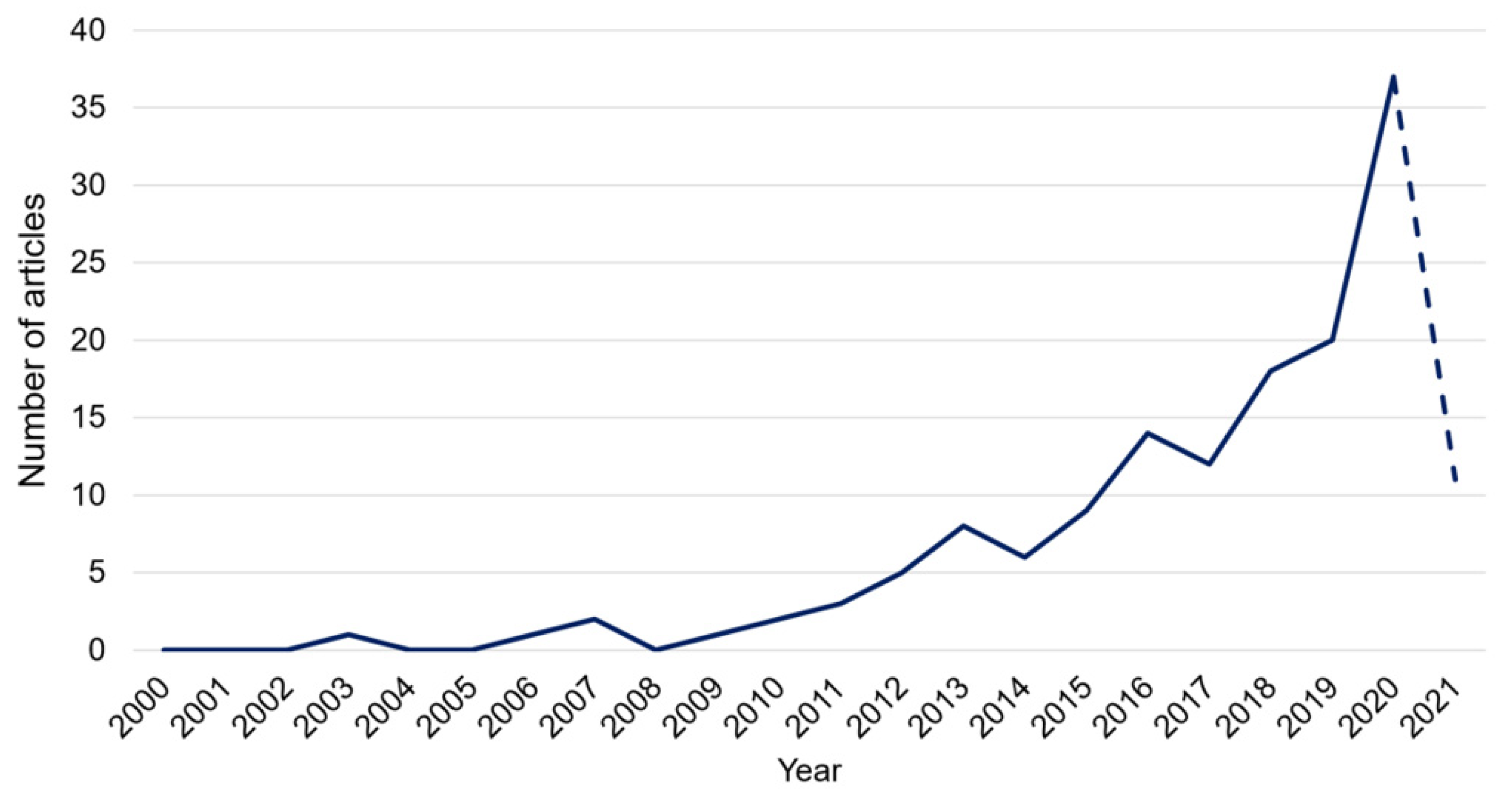
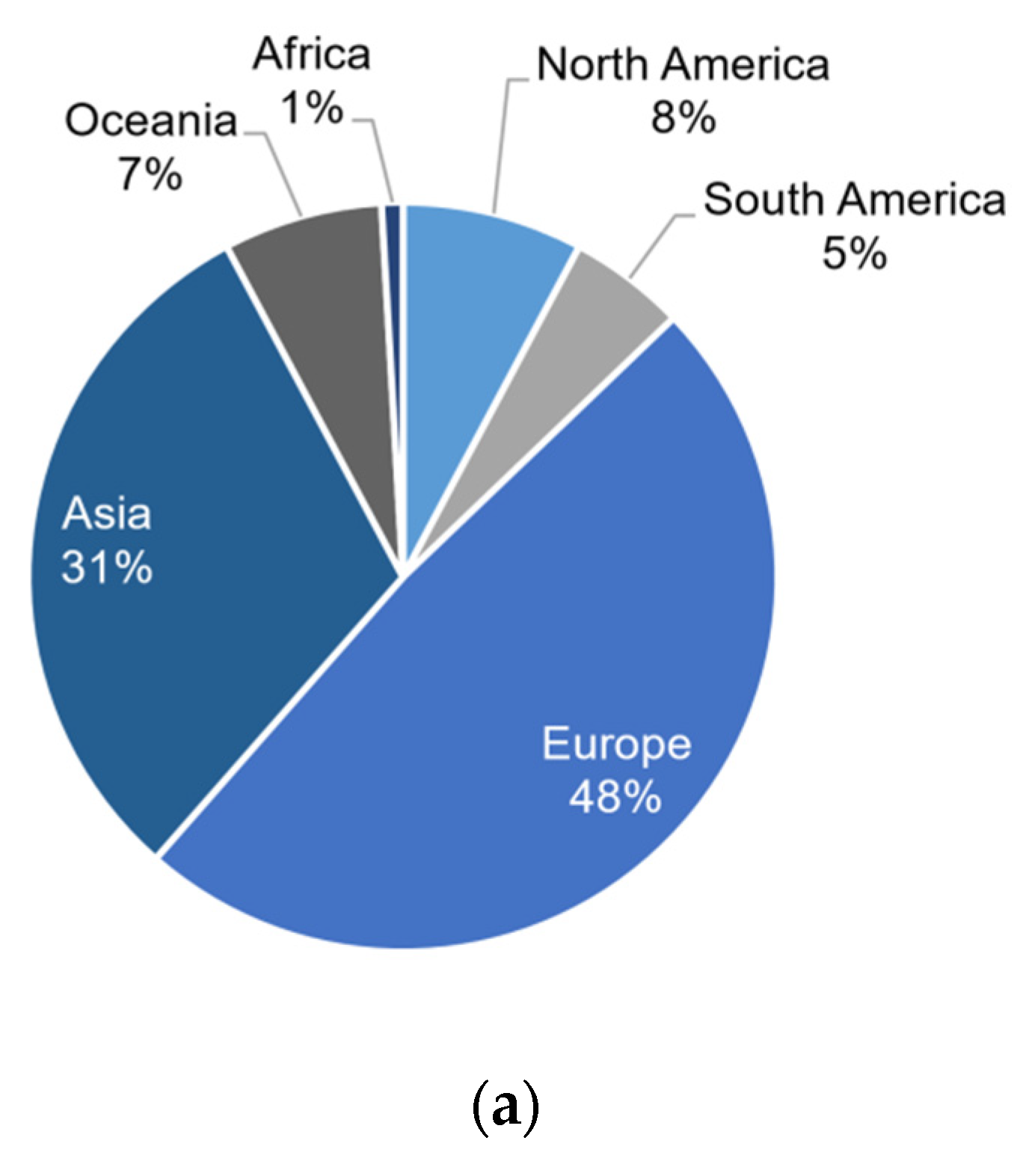
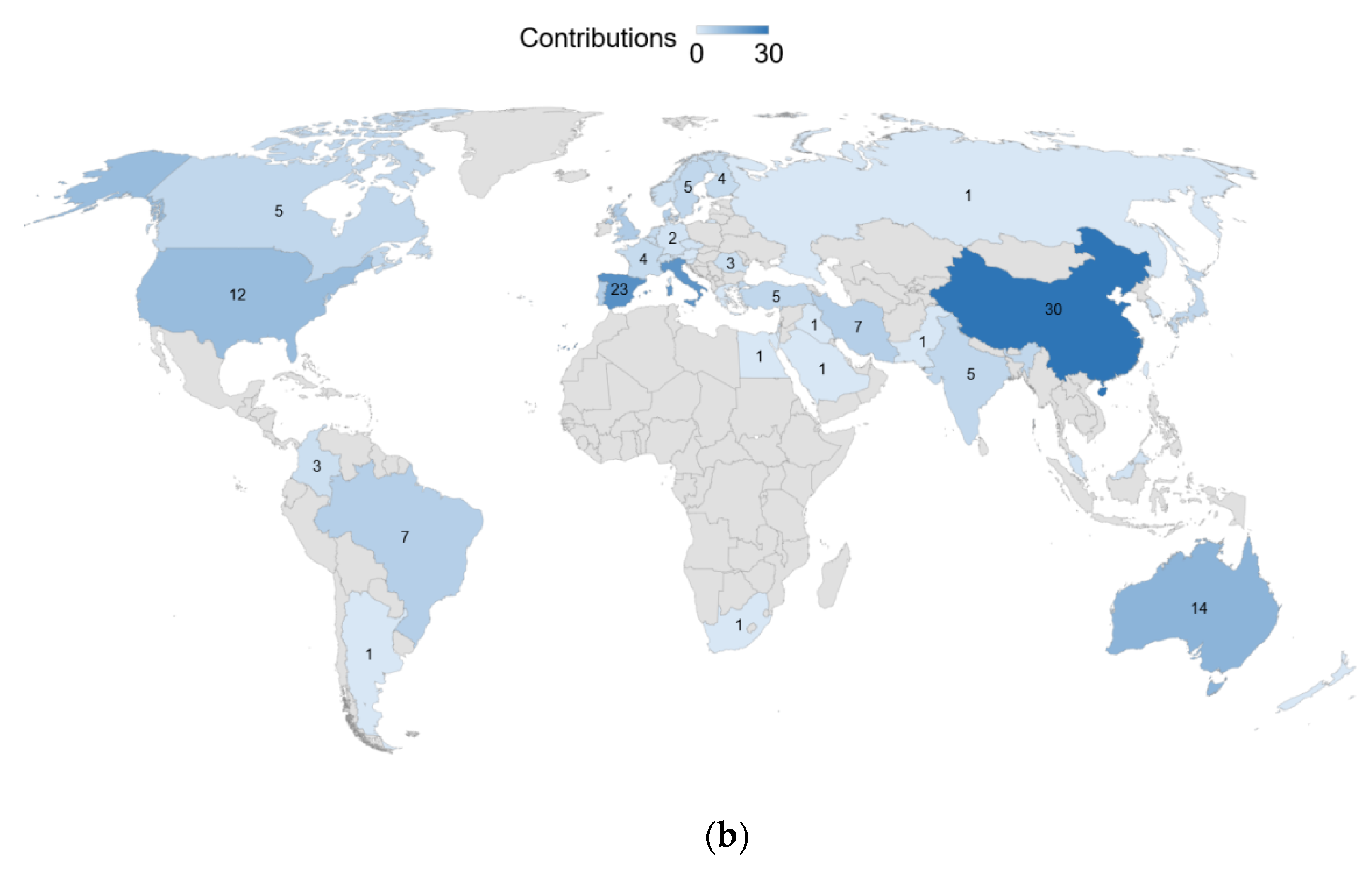
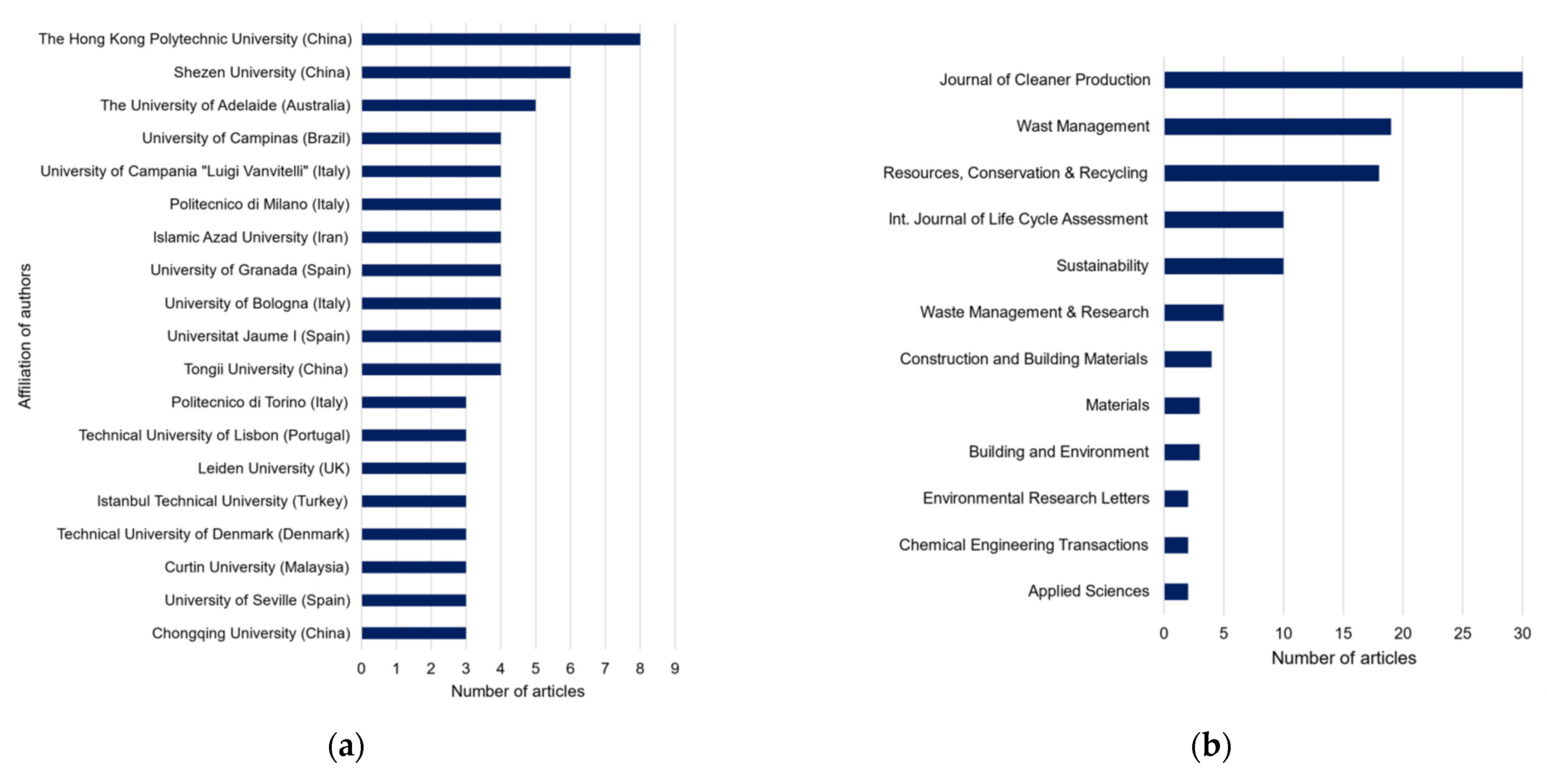
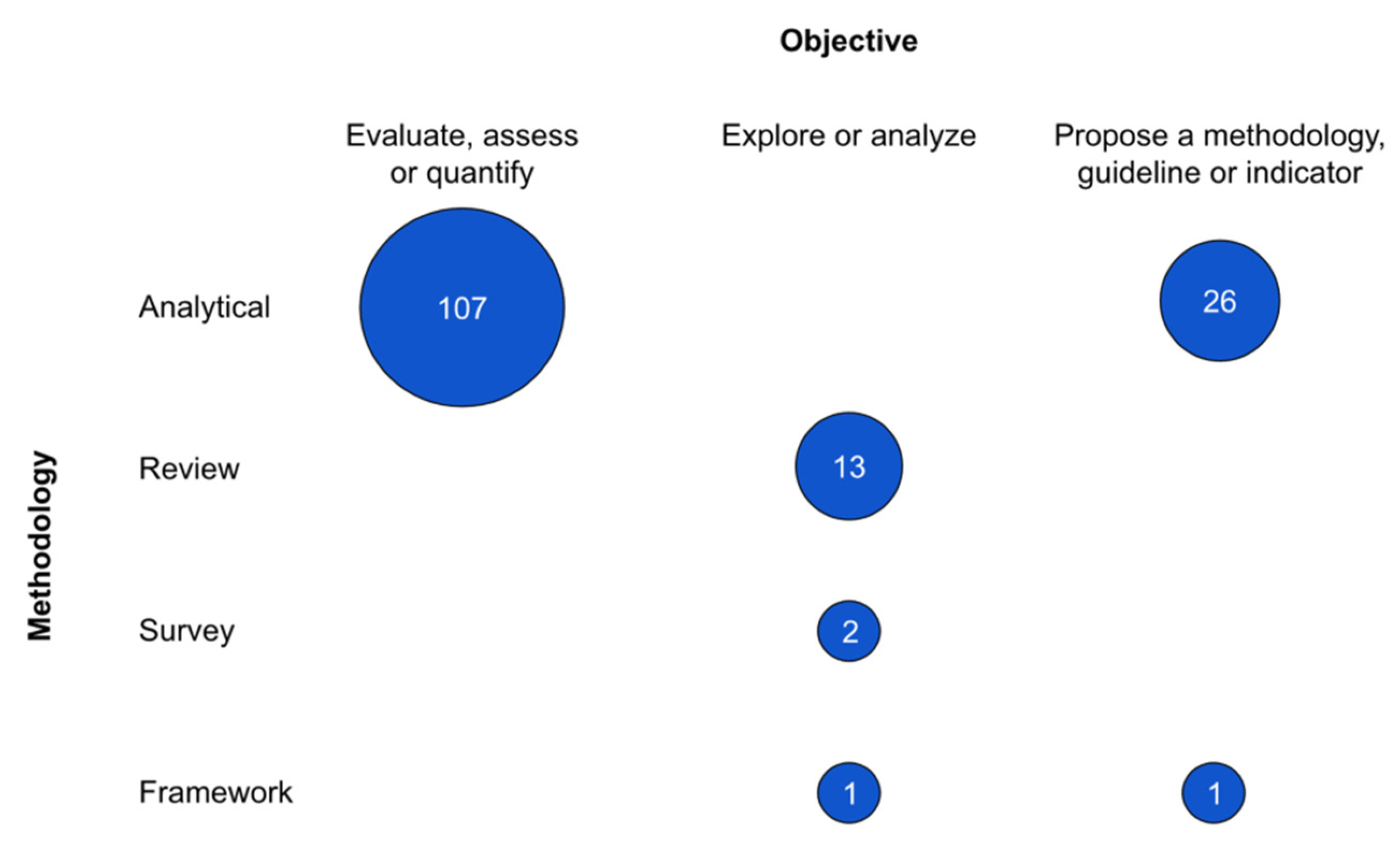
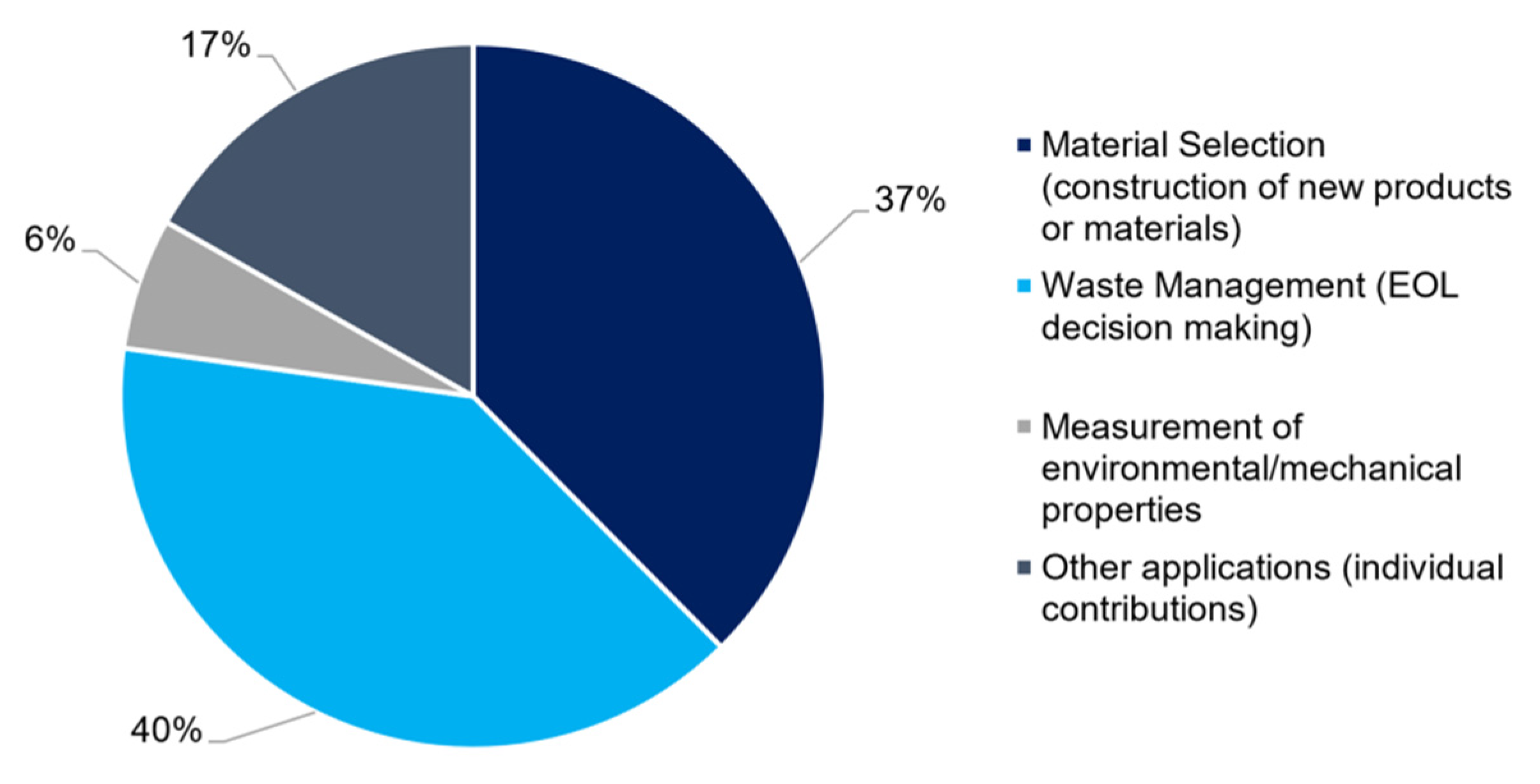


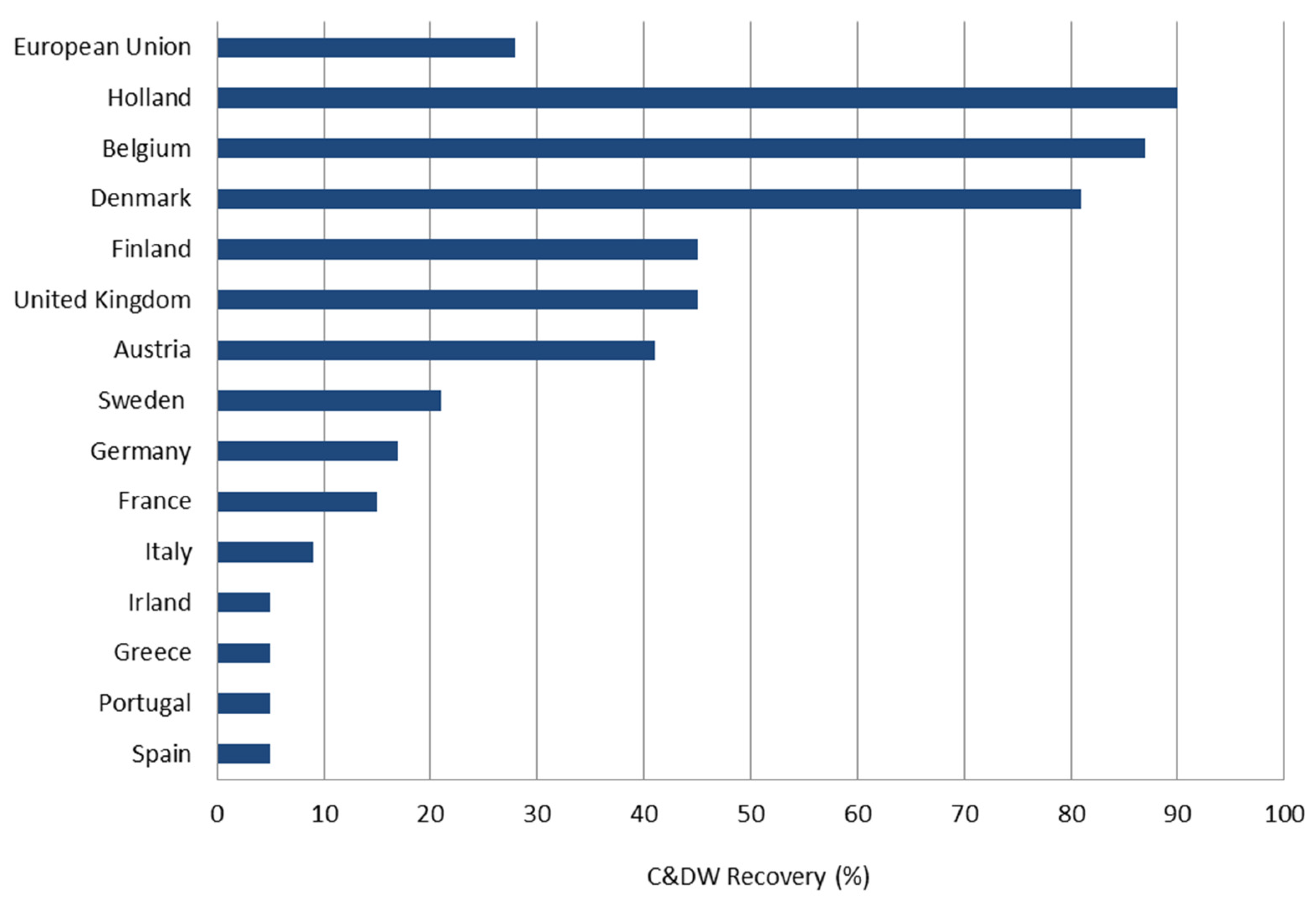
| Investigated Aspect | Categories | Category Definition |
|---|---|---|
| Objective | Evaluate, assess, or quantify | The article aims to measure life cycle impacts and compare data |
| Propose methodology, guideline, or indicator | The article proposes a new methodological approach or indicator | |
| Explore or analyze | The article analyzes relationships, data, and results from previous research | |
| Methodology | Analytical | The article is based on analytical models, experimentation, or mixed approaches to calculate and determine key indicators and compare results |
| Framework | The article proposed a framework to analyze and evaluate EOL scenarios or life cycle implications of using C&DW materials | |
| Review | The article employed a literature review approach | |
| Survey | The article gathers information and research gaps from surveys | |
| Applicability | EOL decision making | The article provides helpful information to compare and select the most suitable EOL scenario |
| Material selection | The article provides helpful information to select materials in the fabrication of new products | |
| Measurement of sustainability impacts | The article provides helpful information about how to measure sustainability impacts in a nonconventional way |
| Time Interval | ||||
|---|---|---|---|---|
| 2015 to 2021 | 2010 to 2014 | 2005 to 2009 | 2000 to 2004 | |
| References | [1,5,6,7,8,9,10,11,12,13,14,19,20,21,22,23,24,25,26,27,28,29,30,31,32,33,34,35,36,37,38,39,40,41,42,43,44,45,46,47,48,49,50,51,52,53,54,55,56,57,58,59,60,61,62,63,64,65,66,67,68,69,70,71,72,73,74,75,76,77,78,79,80,81,82,83,84,85,86,87,88,89,90,91,92,93,94,95,96,97,98,99,100,101,102,103,104,105,106,107,108,109,110,111,112,113,114,115,116,117,118,119,120,121,122,123,124,125,126] | [3,4,15,18,127,128,129,130,131,132,133,134,135,136,137,138,139,140,141,142,143,144,145,146] | [17,147,148,149] | [150] |
| Research Works | Most Relevant Authors | Topics Studied |
|---|---|---|
| [22,60,68,71,72,86,99] | LP Rosado; P Vitale; C Penteado | LCA of natural and mixed recycled aggregate; Waste management of C&DW; Influence of disposal fees on municipal waste management of C&DW; LCA of EOL of residential buildings; Attributional LCA of Italian residential multifamily building. |
| [56,57,70,85] | MD Uzzal Hossain; CS Poon | Comparative environmental evaluation of construction waste management; Comparative environmental evaluation of aggregate production from C&DW; Upcycling wood waste into cement-bonded particleboard |
| [31,62,76,91,151] | S Zanni; A Bonoli; GM Cuenca-Moyano | Environmental assessment and life cycle inventory of mortars made of natural and recycled aggregates; Framework for circular economy in buildings; Environmental impact of natural inert and recycled C&DW processing using LCA. |
| [74,82,96,124] | S Pantini; L Rigamonti; G Borghi | Selective demolition; resource-efficient management of asphalt waste; resource-efficient strategies for managing post-consumer gypsum; LCA of nonhazardous C&DW |
| Reference | Citations | Brief Description |
|---|---|---|
| Laurent 2014 [18] | 323 | Review article that analyzes the knowledge from 222 published LCA studies of solid waste management systems from 1995 to 2012. |
| Blenglini 2009 [17] | 286 | Study about LCA of residential buildings in an urban area under demolition and redesign. |
| Yeheyis 2013 [15] | 179 | Framework to maximize the implementation of 3R strategies (reduce, reuse, and recycling) and minimize the disposal of construction and demolition waste through the use of LCA. |
| Blengini 2010 [141] | 155 | Analysis of environmental implications of C&DW recycling chain in Torino, Italy, using a geographical information system and LCA. |
| Bianchini 2012 [127] | 129 | Review article that analyzes the social cost–benefit of green roofs. A case study involves the use of C&DW for constructing roof layers. |
| Coelho 2012 [145] | 119 | Study of environmental impacts of buildings through their whole life cycle considering different waste/material management options. |
| Hossain 2016 [56] | 119 | Comparative LCA of aggregate production using recycled waste materials and virgin sources from first-hand data. |
| Ortiz 2010 [3] | 112 | Evaluation of environmental impacts of construction waste in terms of the Life Program Environment Directive of the European Commission. |
| Cao 2015 [42] | 110 | Comparison between prefabrication technology and cast in situ technology. Environmental performance is evaluated through LCA. |
| Knoeri 2013 [132] | 108 | Analysis of life cycle impacts of recycled concrete mixtures with different cement types and compared to conventional concrete. |
| Dahlbo 2015 [43] | 106 | Assessment of the performance of C&DW management systems from an environmental and economic perspective. |
Publisher’s Note: MDPI stays neutral with regard to jurisdictional claims in published maps and institutional affiliations. |
© 2021 by the authors. Licensee MDPI, Basel, Switzerland. This article is an open access article distributed under the terms and conditions of the Creative Commons Attribution (CC BY) license (https://creativecommons.org/licenses/by/4.0/).
Share and Cite
Mesa, J.A.; Fúquene-Retamoso, C.; Maury-Ramírez, A. Life Cycle Assessment on Construction and Demolition Waste: A Systematic Literature Review. Sustainability 2021, 13, 7676. https://doi.org/10.3390/su13147676
Mesa JA, Fúquene-Retamoso C, Maury-Ramírez A. Life Cycle Assessment on Construction and Demolition Waste: A Systematic Literature Review. Sustainability. 2021; 13(14):7676. https://doi.org/10.3390/su13147676
Chicago/Turabian StyleMesa, Jaime A., Carlos Fúquene-Retamoso, and Aníbal Maury-Ramírez. 2021. "Life Cycle Assessment on Construction and Demolition Waste: A Systematic Literature Review" Sustainability 13, no. 14: 7676. https://doi.org/10.3390/su13147676







